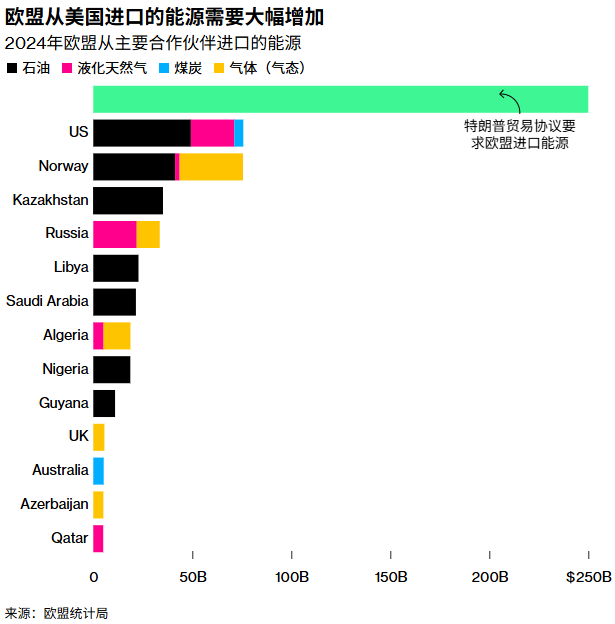Huge promises vs. market reality: is the EU's 750 billion energy purchase difficult to fulfill?
The Zhitong Finance App notes that the EU promised to import 750 billion US dollars of energy from the US within three years. This promise is critical to reaching a trade agreement with US President Trump, but actual implementation will face huge challenges.
According to the agreement, the EU is required to purchase 250 billion US dollars of natural gas, oil and nuclear energy technology (including small modular reactors) every year. European Commission President von der Leyen said the estimate was based on an existing plan — to get rid of dependence on Russian fossil fuels and buy “more cost-effective” liquefied natural gas from US producers.
But it is difficult for the EU to meet such ambitious import targets in the short term. The total amount of energy imported by the EU from the US last year was less than 80 billion US dollars, far from von der Leyen's promise to Trump. There is also uncertainty about the potential role of European investment in the US energy sector.
The EU has yet to provide specific data details; how to persuade private companies to trade US oil and gas is still unknown.
“Unless the US government sells LNG directly, or the EU purchases it at a higher price than the Asian market, this agreement will not change the market balance.” Rabobank energy strategist Florence Schmidt said. Even if the agreement boosts EU investment in US LNG projects, related energy flows will be difficult to achieve until Trump's term ends.

This is not the first time that Europe and the US have made such promises. When the Russian-Ukrainian conflict triggered the European energy crisis in 2022, von der Leyen reached an agreement with President Biden to increase the short-term supply of LNG by 15 billion cubic meters. But the scale of this agreement far exceeds the previous one — US total energy exports last year were only $330 billion.
Maximo Michinelli, head of EU energy and climate at the consulting firm FleishmanHillard, stated: “$750 billion is too huge for a three-year period, and it is unclear exactly what energy sources other than LNG are covered. This may require long-term negotiations on the EU's energy needs over the next ten years.”
The EU model shows that as the green transition accelerates, its demand for natural gas will gradually decline.
Investment-driven
As the world's largest producer of LNG, the US will release new production capacity in the next few years. Analyst Han Wei said, “What the Trump administration really values is signing new project supply agreements with European buyers, which helps to obtain project financing. Creating jobs and boosting investment, rather than quickly resolving the trade deficit between the US and Europe, is its realistic goal.”
It's worth noting that US LNG is generally not specific to the destination. Although Europe has been the biggest buyer since the 2022 crisis, it still has to compete with Asian customers. The joint procurement platform set up by the European Union has had little effect, and the details of the deal reached are still unclear.

The US is Europe's second-largest supplier of natural gas
Jean-Christian Heinz, a former energy trading executive and now an independent consultant for Wideangle LNG, said: “It is difficult to see this as a victory for the EU. Ultimately, member states will still have to decide for themselves to cooperate with the Trump administration.” Although EU energy commissioner Kadri Simson has stated that he is willing to help US suppliers meet methane emission standards, the adjustments may be limited to the technical level.
Petroleum and nuclear energy layout
According to data analysis company Kpler, in the first half of 2025, the EU imported 1.53 million barrels of oil (86% crude oil) from the US per day, worth about US$19 billion, accounting for 14% of its average daily consumption of 10.66 million barrels.
Nuclear energy may be a breakthrough towards unrealistic goals, and the small modular reactors being developed by the US and Europe may be the key. The EU's nuclear energy expansion plan to achieve the 2050 climate neutrality target is expected to cost 241 billion euros (280 billion US dollars).
 Wall Street Journal
Wall Street Journal